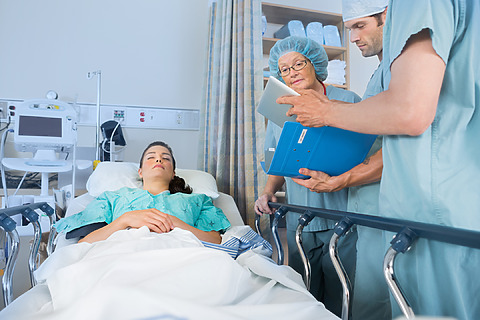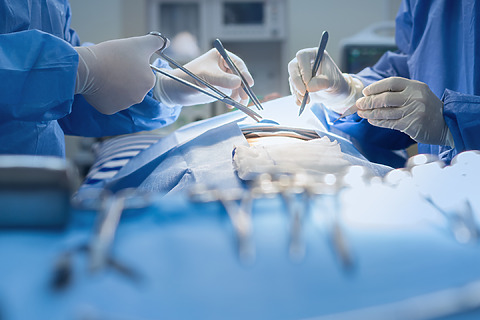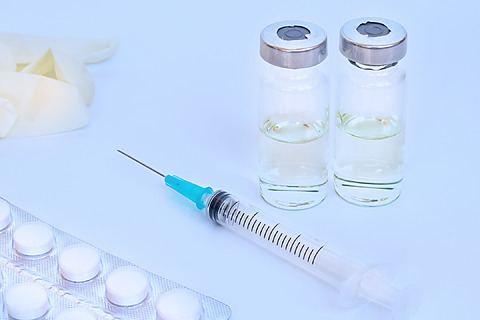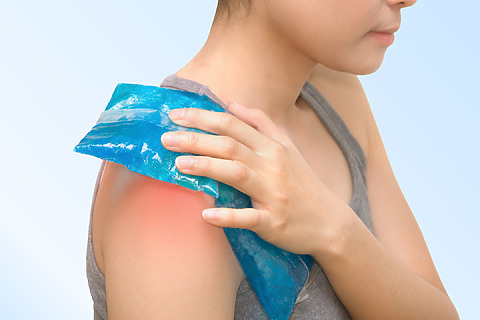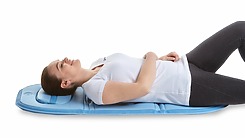Biomag - Encyclopedia - Post surgery condition
Post surgery condition - symptoms, description and treatment

Author MUDr. Peter Bednarčík CSc.
Revision

Surgery always means an intervention in the body, a stay in hospital and varying lengths of healing time. It is therefore worth knowing before surgery what the post-operation is like, the post-operative care, and what complications may occur. With the right approach, you can accelerate and shorten the healing time.
Find out what the operation entails, and how best to control symptoms such as pain, swelling and inflammation that accompany it. Are there ways to recover as quickly as possible? Read more here.
Common symptoms post surgery
- Pain
- Fatigue
- Nausea and vomiting – can be a side effect of anaesthesia or analgesics
- Lesser appetite
- Swelling and bruising
Post-surgery symptoms may vary depending on the type of surgery performed, the patient’s health, age and many other factors.
If you are experiencing anything unusual, do not hesitate to consult your doctor immediately. This may indicate post-surgery complications, and these should be dealt with immediately.

Only a doctor can make a correct diagnosis. Do not use this or any other article on the internet to make a diagnosis. Do not delay seeing a doctor and address your condition early.
Operation and post-operation - description
What is an operation?
An operation is a surgical procedure in which a surgeon examines or treats a patient using various surgical techniques and instruments. Surgery may involve the removal of part of an organ. [1]
Post-operation is the period that follows the surgical procedure. It includes the recovery and convalescence phase.
The course of recovery after surgery and its duration vary depending on the type of surgery. Pain management and wound care are usually the most important aspects of post-operative care. The post-operative process often also includes physiotherapy and other procedures to enable a return to normal life. To ensure a smooth and speedy recovery, it is important to follow the instructions of doctors and other health professionals. [2]
Surgery - photogallery
Did you know?
- The most common form of wound infection is superficial infection during the first week after surgery.
- A complication in the form of wound spacing occurs most often between the 7th and 10th day after the procedure.
- Deep vein thrombosis and pulmonary embolism are among the main postoperative complications and are often fatal for patients. [3]
Post-surgery complications
Every operation has its risks. After the procedure, there may be various unpleasantnesses that gradually subside, or postoperative complications that affect the surgical site or the whole organism.
Inconveniences include:
– nausea and vomiting caused by anesthesia,
– throat irritation after intubation (insertion of a tube into the airway to ensure breathing during surgery),
– pain and swelling at the site of surgery,
– fatigue and difficulty sleeping,
– various digestive problems.
The most common post-operation complications of a serious nature are:
- Shock – a condition that threatens the life of the patient due to circulatory failure and impaired organ function.
- Bleeding – loss of blood at the site of the procedure.
- Pulmonary complications – changes in breathing depth and limited coughing in the first two days after surgery can lead to various breathing difficulties.
- Deep vein thrombosis – the formation of a blood clot in a large vein in the legs, arms or other part of the body.
- Pulmonary embolism – the wedging of a blood clot in the lungs, which fundamentally disrupts their function.
- Infection in the wound – inflammation can threaten the healing of the wound and the surrounding tissues or organs.
- Urinary retention – after surgery, voiding may be impaired, for example due to catheterisation during surgery.
All of these conditions require prompt intervention by a physician who will determine the appropriate course of action and treatment. Depending on the type of complication, this may include respiratory support, blood transfusion, administration of antibiotics and blood thinners, or reopening of the surgical wound. [4]
Complications after surgery are also divided into early postoperative complications and late postoperative complications.
Early postoperative complications include: fever, pain, changes in perception, bleeding, thrombosis, urological problems or impaired wound healing. Late postoperative complications include: hernia, various adhesions, failure of the operation and the need to repeat the procedure, keloid scar (thick raised scar).[5]
In many cases, early postoperative complications occur during hospitalisation and can therefore be detected and managed by a doctor in the hospital. Possible late complications indicate that it is necessary to monitor the health status even after discharge to home treatment and to seek medical care in case of any doubts. In general, after surgery, it is necessary to monitor mainly pain, fever, swelling and signs of infection.[6]
Venous thrombosis
Infection
Pulmonary embolism
Bleeding

We recommend not delaying treatment
Do not delay treatment , and if you have any health problems or doubts about your health, see a medical professional. This will prevent unnecessary health complications.
Treatment – What happens post-surgery?
Successful recovery and strengthening of the weakened body are essential steps for patients after surgery to get back to work and daily activities.
What is key in recovery?
- Remember to take all medications as recommended by your doctor.
- Monitor your health to detect any complications early.
- Take care of your diet – healthy foods and plenty of protein and vitamins will strengthen your whole body.
- Don’t overexert yourself and rest.
- Return to physical activity should be gradual. [7]

Beware
Post-operation treatment can only be determined by your doctor after considering your overall health. Therefore, do not use this article as a guide to treatment, which can only be determined by a doctor.
Pain post-surgery and medication
The first postoperative days can be marked by pain. The type and intensity of pain depends on the type and extent of the operation. Accordingly, the doctor will determine what pain medication will be most appropriate.
The most commonly used medications for postoperative pain include:
- Opioids – drugs intended for moderate to severe pain.
- Non-steroidal anti-inflammatory drugs – relieve mild pain, reduce inflammation and reduce swelling
- Paracetamol – counteracts mild pain and fever, has no anti-inflammatory effects. [8]
Taking pain medication provides relief from discomfort, facilitates recovery after surgery and reduces the risk of certain postoperative complications.
Postoperative treatment may also include local anaesthetics to provide local anaesthesia and prevent pain perception. If the patient’s postoperative condition requires it, doctors may also administer psychoactive drugs that affect consciousness, emotions and mood.
Postoperative pain management measures also include cold compresses, various relaxation techniques and alternative pain relief methods. [9]
Postoperative wound and scar care
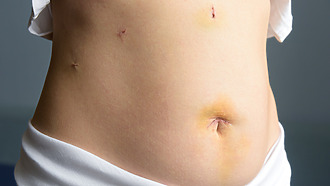
After each surgery, a postoperative wound and subsequent scar is left on the body at the site of the procedure. Open surgeries, in which the surgeon enters the surgical site through a conventional incision, result in larger scars. On the other hand, laparoscopic operations (inserting surgical instruments through small holes) leave patients with only keyhole-sized wounds.[10]
A postoperative wound can be a source of infection, so it needs to be cared for properly.
The main principles can be summarised in a few points:
- Wash your hands before and after touching the wound.
- Check the condition of the wound or fresh scar regularly. Concentrate on its colour, any secretions from the wound and the consistency of the stitches.
- Maintain the dressing interval and use special coverings and plasters recommended by your doctor.
- Do not soak the wound several days after surgery and wait to shower until your doctor allows it. Swimming and bathing is appropriate only after a firm scar has formed.
- Sneezing and coughing may cause the wound to spread in the first few days after surgery. Therefore, when coughing, apply pressure against the scar (with your hands or a pillow) to avoid compromising the integrity of the sutured area.[11]
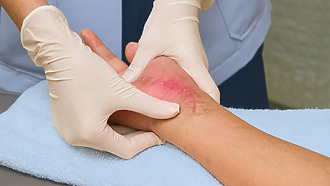
Once the scar is formed, you can start lubricating it and applying pressure or other massage as recommended by your doctor. Proper and regular care will help create a smooth, supple and painless scar.
- Do not scratch the scar or irritate it, for example by wearing tight clothing.
- Use gentle, non-perfumed products for lubrication.
- Avoid direct sunlight, which can cause permanent darkening of the scar.
If the condition of the scar worsens after surgery and swelling, redness or other changes appear, consult your doctor about its appearance. The scar will not take its final form until 12-18 months after surgery. [12]
Prognosis and lifestyle after surgery
If the patient’s condition immediately after surgery is uncomplicated, they are transferred from the intensive care unit to a regular hospital room after a short period of time. The length of stay in the ICU ranges from a few hours to several days, depending on the type of surgery.
The postoperative condition and its prognosis are related to the underlying disease and the reason for the operation. In general, if patients follow all instructions and recommendations from the doctor, they will gradually recover and return to normal life in the home environment. [13]
- Surgery and subsequent recovery can cause loss of muscle mass. Before and after surgery, it is therefore worthwhile to ensure a good diet with sufficient nutrients and protein.
- A proper diet will help speed recovery and reduce the risk of various post-operative complications.
- Do not forget to drink enough. Hydration is important for circulation.
- After surgery, start moving as soon as possible to regain the muscle strength you need.
- Follow the advice of your doctor or physiotherapist. [14]
Alternative and additional therapeutic methods
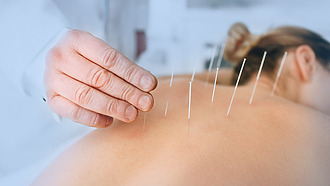
Acupuncture – alternative pain treatment after surgery
Healing and recovery after surgery can be supported by various alternative methods. For example, homeopathy, acupuncture, massage or various relaxation techniques can be used. [15]
- Massage promotes blood circulation, relieves pain, improves range of motion and can improve scar condition. [16]
- Acupuncture relieves various types of pain and can reduce post-surgery swelling. [18]
- Supportive homeopathic treatment guided by an experienced homeopath can have a beneficial effect on pain, itching, swelling or bruising at the surgical site. It is also used to relieve fatigue or anxiety associated with the procedure. [19]

Important information post surgery
The goal of postoperative care is to recover as quickly as possible and return to normal life.
During recovery, you need to monitor the condition of the wound and scar to avoid possible complications with healing.
Do not underestimate the importance of good nutrition, drinking, and exercise in the postoperative period.
Summary and recommendations post-operation
See your Physician
Post-operation treatment is always determined by your doctor based on a general examination, an assessment of your condition and an accurate diagnosis.
Causal Treatment of Pain
After a general examination, your doctor will recommend treatment. In connection with this, they will also recommend possible lifestyle modification and further courses of action.
Relieving Pain, Swelling and Inflammation
Symptomatic treatment focuses on the manifestations or symptoms of the disease. Such treatment can significantly improve your quality of life and support comprehensive treatment.
Sources, references and literature
[1] NCI Dictionary of Cancer Terms. National Cancer Institute. Available at: https://www.cancer.gov/publications/dictionaries/cancer-terms/def/surgery
[2] Pietrangelo A. Postoperative Care. Healthline, 7. July 2018. Available at: https://www.healthline.com/health/postoperative-care
[3] Willacy H. Common Postoperative Complications. Patient.info, 1. November 2020. Available at: https://patient.info/doctor/common-postoperative-complications-pro
[4] After Surgery: Discomforts and Complications. Johns Hopkins Medicine. Available at: https://www.verywellhealth.com/post-surgery-recovery-tips-and-guide-3156833
[5] Willacy H. Common Postoperative Complications. Patient.info, 1. November 2020. Available at: https://patient.info/doctor/common-postoperative-complications-pro
[6] Willacy H. Common Postoperative Complications. Patient.info, 1. November 2020. Available at: https://patient.info/doctor/common-postoperative-complications-pro; Post-Operative (After Surgery) General Instructions. UK HealthCare. Available at: https://ukhealthcare.uky.edu/orthopaedic-surgery-sports-medicine/resources/post-operative-general-instructions
[7] Pietrangelo A. Postoperative Care. Healthline, 7. July 2018. Available at: https://www.healthline.com/health/postoperative-care
[8] Sissons B. What pain medications can a person take after surgery? Medical News Today, 24. February 2023. Available at: https://www.medicalnewstoday.com/articles/list-of-pain-medication-after-surgery
[9] Sissons B. What pain medications can a person take after surgery? Medical News Today, 24. February 2023. Available at: https://www.medicalnewstoday.com/articles/list-of-pain-medication-after-surgery
[10] Laparoscopy (keyhole surgery). NHS, 1. August 2018. Available at: https://www.medicalnewstoday.com/articles/list-of-pain-medication-after-surgery
[11] Whitlock J. Recovery After Surgery. Verywell Health, 14. July 2023. Available at: https://www.verywellhealth.com/post-surgery-recovery-tips-and-guide-3156833
[12] Scar Information – Caring For Your Scar. Hull University Teaching Hospitals NHS Trust, 2. January 2023. Available at: https://www.hey.nhs.uk/patient-leaflet/scar-information/
[13] Pietrangelo A. Postoperative Care. Healthline, 7. July 2018. Available at: https://www.healthline.com/health/postoperative-care
[14] Pre and Post Surgery Nutrition and Lifestyle Strategies to Optimize your Recovery. Canadian Digestive Health Foundation, 1. December 2022. Available at: https://cdhf.ca/en/pre-and-post-surgery-nutrition-and-lifestyle-strategies-to-optimize-your-recovery/
[15] Alternative Methods to Help Manage Pain After Orthopaedic Surgery. OrthoInfo, October 2011. Available at: https://orthoinfo.aaos.org/en/recovery/alternative-methods-to-help-manage-pain-after-orthopaedic-surgery/
[16] Post Surgery. Physio.co.uk. Available at: https://www.physio.co.uk/treatments/massage/when-can-massage-help/post-surgery.php
[17] Alternative Methods to Help Manage Pain After Orthopaedic Surgery. OrthoInfo, October 2011. Available at: https://orthoinfo.aaos.org/en/recovery/alternative-methods-to-help-manage-pain-after-orthopaedic-surgery/
[18] Surgery and Recovery Support (Homeopathy). PeaceHealth, 31. October 2012. Available at: https://www.peacehealth.org/medical-topics/id/hn-2259000
| Rate this article |
|
|
5/52 Reviewed by
|
How to control pain, swelling and address inflammation?
The solution may be symptomatic treatment using pulsed magnetic therapy, which targets symptoms and signs such as pain, swelling and inflammation. In addition, such treatment can support comprehensive treatment and significantly improve quality of life.
Explaining the Effects
The basic principle of Biomag 3D pulsed magnetic therapy (PEMF therapy) is the generation of electromagnetic pulses. These pulses penetrate through clothing and through the entire depth of the tissue to the point of targeted application. The pulses have specially developed biotropic parameters (e.g. frequency, shape, intensity) to best affect various health problems.
What are the effects of 3D magnetic therapy (PEMF therapy)?
- Helps relieve pain.
- Mitigates inflammation.
- Suppresses swelling.
How is the treatment applied?
The application is very simple. You select the desired therapeutic effect on the device and attach the supplied applicator to the desired application site. Magnetic therapy is usually applied 2 times a day for 20 minutes.
We will be happy to help you try this method and advise you on which device to purchase.
